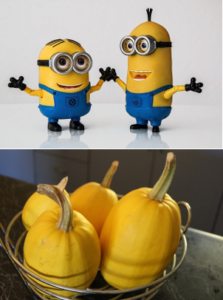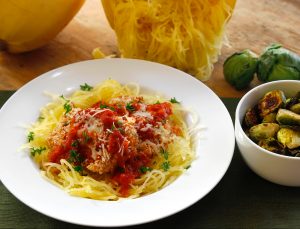 I still remember our first encounter with spaghetti squash…
I still remember our first encounter with spaghetti squash…
we were at the farmers’ market, feeling pretty adventurous so we decided to buy one.
It was more out of curiosity whether it would really turn into noodles the way people described.
We got home and realized we had no idea what do to with it. We didn’t know how to cut it, didn’t have the first clue how to cook it, and were skeptical that we would end up with anything that resembled “noodles.” Needless to say, we were in for a surprise!
After just one experience, we were hooked!
Especially during the fall, spaghetti squash has become a regular feature at our dinner (and breakfast) table — the kids love it too! You’ll be hard-pressed to find a more fascinating vegetable. We use it as an alternative to pasta, as a simple side dish and other delicious ways (even pancakes!). If you haven’t yet experienced the wonder of the spaghetti squash, now is the perfect time to get the freshest harvest of the season!
What is a spaghetti squash?
 The spaghetti squash is part of a group of plants that includes winter squash, pumpkin and summer squash. Did you know that, technically, any plant that flowers and produces something that contains seeds is considered a fruit?
The spaghetti squash is part of a group of plants that includes winter squash, pumpkin and summer squash. Did you know that, technically, any plant that flowers and produces something that contains seeds is considered a fruit?
So, I guess…botanically…the spaghetti squash is a fruit (just like a tomato, bell pepper and anything else that contains seeds). However, in the culinary world, spaghetti squash is considered a vegetable, so in the end…call it what you like!
There are many reasons to love spaghetti squash!
- Fantastic alternative to pasta! Not only does spaghetti squash only have 50 calories per cup (vs. 200 calories for pasta), but it’s perfect for those trying to avoid gluten.
- Provides excellent nutrition! Spaghetti squash is very high in Vitamins A & C, and also provides great antioxidants like beta-carotene. It’s a good source of potassium (to help manage high blood pressure) and contains fiber to help keep you full longer.
- Easy to grow and is available year-round.
- Spaghetti squash noodles cook up to a delicious crisp-tender consistency. And, any leftovers continue to hold this crisp tenderness, so they are still great the next day.
- The noodles have a very mild flavor, so it works well in both savory and sweet dishes.
A few things to know…
HOW TO PICK:
 The spaghetti squash should look lemon-yellow. It’s perfectly fine if there are varying colors of yellow, but you don’t want it to be green or white or have soft spots.
The spaghetti squash should look lemon-yellow. It’s perfectly fine if there are varying colors of yellow, but you don’t want it to be green or white or have soft spots.- It should feel heavy for its size.
- Avoid any bruises or a cracked stem.
HOW TO STORE:
- Store in a cool, dark place where it will keep for up to 2-3 months.
- Only store in the refrigerator once it has been cut. Store cut squash wrapped in plastic wrap or place in an airtight container.
- Cooked spaghetti squash will keep in the refrigerator for 3 to 5 days.
To learn how to prepare it and cook it, keep reading or check out our Spaghetti Squash 101 video!
HOW TO PREPARE:
You can cut a spaghetti squash either lengthwise or crosswise, either way is correct! One benefit to cutting it crosswise is you don’t have to cut through the stem.
Scoop out the seeds before cooking! You may have seen videos where people didn’t do this…we can tell you from personal experience that it is much easier to scoop out the seeds BEFORE cooking!
HOW TO COOK:
- Bake: Place cut side down on a baking sheet and bake at 350 degrees for 40-60 minutes, depending on the size of your spaghetti squash. We have also tried cooking cut side up and that works well too! While roasting takes longer, it does bring out a more intense flavor (as does roasting most vegetables).
- Microwave: This is our favorite way to cook a spaghetti squash because IT’S FAST! Place each cut half in a microwave safe dish (such as a glass baking dish), with 1/4 cup of water and cook for 6-7 minutes, depending on the side. If you overcook it, it can turn a little mushy. If in doubt, start with less time – you can always add more, but you can’t reverse it if you overcook it.
HOW TO KNOW WHEN IT’S DONE!
(Remember…be sure to let it cool slightly after cooking!)
- Press on the outside of the end and you should be able to press a slight dent in it.
- Use a fork and poke the deepest part of the inside of the squash…your fork should easily pierce it.
- When it’s done, use a fork and shred the inside of the spaghetti squash into “noodles.”
Some of our favorite ideas:
 Baked Chicken Parmesan over Spaghetti Squash Noodles
Baked Chicken Parmesan over Spaghetti Squash Noodles- Moroccan Spaghetti Squash
- Spaghetti Squash Noodle Bowl
- Cincinnati Style Chili Over Spaghetti Squash
- Lasagna Stuffed Spaghetti Squash
- Thai Seafood Curry with Spaghetti Squash
- Garlic and Herb Spaghetti Squash
- Spaghetti Squash Pad Thai
- Spaghetti Squash Pancakes
- Pesto Spaghetti Squash with Kale and Sun-Dried Tomatoes
- Spaghetti Squash Hash
- Avocado Green Curry Spaghetti Squash
- Enjoy a veggie-upgraded meal! Replace the bun and serve the Fire Roasted Sloppy Joes on a bed of spaghetti squash (this works deliciously with chili too!). Check out our video to see how easy it is!
Whether you are a spaghetti squash expert or novice, we hope you will challenge yourself to try spaghetti squash in a variety of ways over the next couple months.
And please be sure to share your results with us!
 LEARN MORE ABOUT THE NAPKIN!
LEARN MORE ABOUT THE NAPKIN!



Leave A Comment